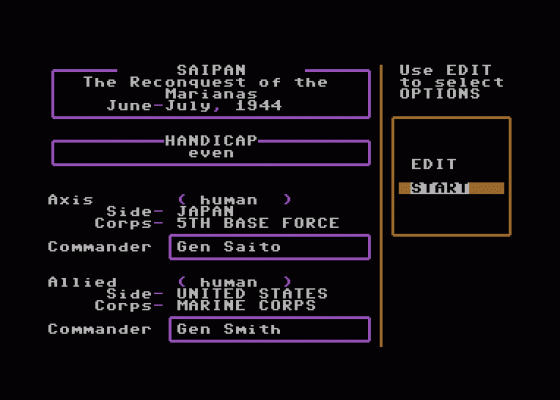
C&VG
 1st January 1987
1st January 1987
Categories: Review: Software
Publisher: Strategic Studies Group
Machine: Commodore 64
Published in Computer & Video Games #63
Battlefront
In World War Two the position of Corps commander was the highest at which a general actually fought battles, instead of planning and controlling them.
This wargame, also by Roger Keating and lan Trent, offers four scenarios for Corps-sized actions - the German airborne corps attack on Crete in 1941, the German drive to relieve the Siege of Stalingrad, the US Marines Invasion of Saipan, and the improvised defence of the Bastogne road-block during the battle of the Bulge. The player takes either side against a computerised or human opponent, and a handicapping system allows beginners the chance to win.
The key to successful command at this level is "thinking two down" - the Corps commander gives orders through his two or three divisions to the regiments underneath.

The program allows access to reports on the state of the regiments at the end of each six-hour move (one in four of which is normally spent asleep!) by a simple menu-driven system which takes an hour or so to master.
After that each of the scenarios can be got through in two or three hours for six to ten game days. The Corps commander learns how to judge the state of his regiments from information on casualties, supply and fatigue, and to give air support and extra divisional resources where they are needed.
The game is strong on realism, keeping the player to his own view point while occasionally reminding him that the troops on the ground may not agree with it! The game's one weak point is its graphics, which are horrible. The map is an almost meaningless jumble of hexes and hard-to-read symbols (printed black-on-black in places) which scrolls in a manner guaranteed to cause the user headaches.

Also, while the two island scenarios are good the others have the problem of Corps command, artificially restricting movement within the area of the map while important things may be happening just out of sight. But, if you don't like these games, design your own!
As with Carriers At War, the program allows the player to construct his own scenarios, adding scenery to the map and specifying the strength of each battalion. The possibilities are endless.
Sea war and air war are, largely, matters of machines. Land war has always been even more a matter of terrain and people, and so is very much harder to model on the computer. Battlefront is a very good attempt, but it is not the perfect game that it might have been.




